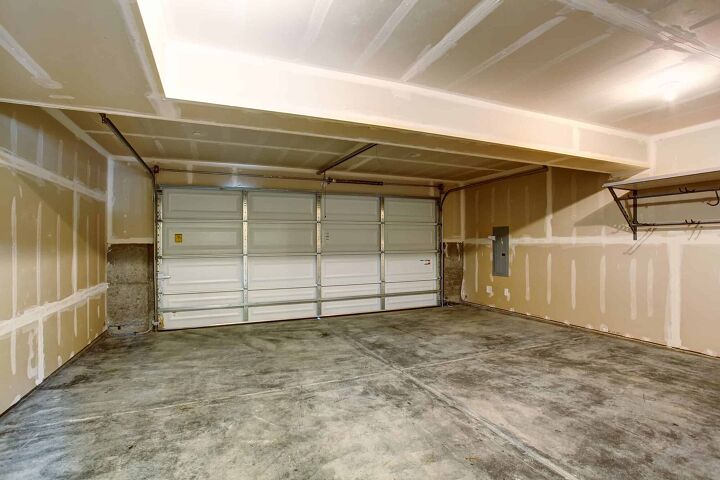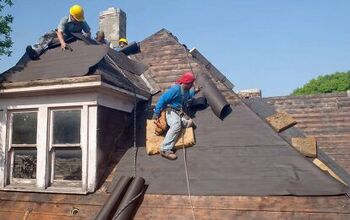How To Fix A Sagging Garage Roof (Step-by-Step Guide)

Garages are an excellent addition to any home. Even if you don’t park your cars in one, a garage still provides you with extra space for storage, tools, and other items you don’t want to keep indoors.
However, your garage won’t always function the way it’s supposed to. Sometimes, issues like a sagging garage roof may require your attention. Fixing this problem isn’t all that complicated.
If you are considering replacing your roof, get a quote from local contractors in your area here.
To fix a sagging garage roof, you need to support or replace the beams. Check to see if they’re rotted or infested with termites before starting. Then, bolster the beams with timber. Start at the eaves and push up on the roof as you work. Secure the beams with 4-inch brass screws.
Do You Need Roofing, Siding, or Gutter Installers?
Get free, zero-commitment quotes from pro contractors near you.

How to Fix a Sagging Garage Roof
What Do I Need to Fix a Sagging Garage Roof?
Your first step towards a solution for your sagging roof is to gather the needed tools and materials. Here’s a list of what you’ll need to get the job done:
- Ladder
- Measuring tape
- Drill
- A friend or two
- Scaffolding planks
- 2×6-inch lumber
- 6-inch nails
- 4-inch brass screws
- Lumber for cross timbers
Step 1: Check the Beams
The first thing you need to do is check your beams. You’re going to be looking for any signs of rot or termite infestation. There are several signs that you can look for to verify whether you have a termite infestation.
Signs of termite damage include:
- Swollen wood
- Buckling wood
- Areas that appear to be suffering from water damage
- Moldy or mildewy scent
If you do find any of these issues, you’re going to want to replace your beams entirely. Termite damage will only get worse with time.
If your beams don’t have any signs of termite damage, then you can move forward with this guide. The following steps will show you how to support your existing garage beams and fix your sagging roof.
Step 2: Buy the Right Timber
It’s important that you purchase the right lengths of timber for the unique measurements of your garage. Your goal should be to purchase timber that’s the same length as the trusses in your roof.
Make sure to double-check the measurements for your trusses. Then, purchase 2×6-inch lumber with a length that matches.
Step 3: Start at the Eaves
Begin the construction process by laying out your wood under each beam. Then, lift up on the eaves side and put a 6-inch nail underneath the beam. This is only meant to temporarily hold the beam in position.
Next, you’re going to do the same thing on the other end of the beam. This is when having a friend to help will make the process much easier. They can hold one side of the beam firmly in place while you work on securing the other.
Once the beam is in its proper position, you’re ready to attach it to the old beam. Do this with your drill and 4-inch brass screws. Purchasing brass screws is important because these won’t rust.
As you work, you’re going to want to push the roof up. You may need to use something to force the roof up while you’re working on it.
Repeat this process until you’ve supported every beam in your garage. Your sagging roof should gradually be lifted as you work. Once you get to the end of the job, the roof should be upright once more.
Step 4: Strengthen the Beams
This step is technically optional. However, it’s a good idea to strengthen your beams now since you’re working on them anyway. Doing so will ensure that the work you’ve done will last for years.
This is also a pretty simple step. Simply purchase a few pieces of timber that span the length of your beams to your garage’s floor. Then, secure these in place under each beam. If you put at least four of these cross timbers in place, your garage roof should last a very long time.
What Causes Roofs to Sag?
If your garage roof is starting to sag, you may be curious as to what’s causing the issue. There are several reasons that your garage roof might be sagging.
The first is that it could be holding too much weight. Roofs are only designed to hold a limited amount of weight. If yours has been shouldering more than it should be, then sagging is one way that it might display that stress.
It’s also possible that your garage roof has undersized rafters or missing internal bracing. This can cause sags in the middle of a roof or drooping along the entire plane of the roof.
Other causes of a sagging roof include improper design, construction, aging, and failures of walls and foundations. Your garage roof’s sagging could be related to any one of these concerns.
How Do You Know If Your Roof is Going to Collapse?
A sagging roof can also be a symptom of more serious structural issues. You may be worried about your roof collapsing after noticing a sag in it.
Roofs that sag don’t always collapse. However, it’s a good idea to understand the warning signs of an impending roof collapse. Understanding these can give you a better idea of how seriously you need to take your current roofing issues.
Warning signs of an impending roof collapse include:
- Repeated or severe leaks
- Cracks in the masonry outside
- Bowed or bent utility pipes near the ceiling
- Windows and doors that are more difficult to open or that open on their own
- Sagging interior ceiling or exterior shingles
If you notice any of these signs, don’t wait for the issue to resolve itself. Instead, make sure that you’re keeping your family safe by getting in touch with a roofing repair specialist right away.
How Can I Prevent My Garage Roof From Sagging?
Maybe your garage roof isn’t sagging yet. However, you could still be worried about this issue happening to you. If so, you might be looking for some ways to prevent your garage roof from sagging.
Typically, roofs sag because they’re holding too much weight. This means that the best way to prevent your roof from sagging is to lighten its load. By taking some weight off of your garage’s roof, you can protect its structural integrity.
The easiest way to do this is by keeping the exterior of your garage’s roof free from debris. Make sure that excess snow and water aren’t pooling on top of it during the winter months.
You may also want to cover your garage’s roof in a lighter material. Tiles can be very heavy and put extra stress on your roof. If you’re concerned about sagging, then consider swapping to a lighter alternative, such as asphalt or metal.
How Much Does it Cost to Fix a Sagging Roof?
Your costs for repairs will vary based on factors like your location and the severity of your roofing issues. However, the average homeowner pays between $300 and $1,100 for a standard roof repair visit.
Of course, the amount you have to pay could be much more if your sagging roof is a sign of a more serious roofing issue. The best way to save yourself from these charges is to take good care of your garage roof all year long.
Is a Sagging Roof Dangerous?
A sagging roof can absolutely be dangerous. Roofs are designed to meet exacting technical specifications. When a part of your roof isn’t able to meet those specifications any longer, the issues can quickly impact other parts of the roof.
That’s why it’s so important that you fix a sagging roof as soon as you notice it. You can either use the system described above to accomplish that or get in touch with a professional roofer to do the work for you.
Do You Need Roofing, Siding, or Gutter Installers?
Get free, zero-commitment quotes from pro contractors near you.

Related Questions
Can foundation problems cause roof problems?
Yes, your roofing concerns may actually be traced back to an issue with your home’s foundation. For example, a foundation drop can occur, which may cause your roof to be saggy or wavy.
Is a sagging roof normal?
No, a sagging roof isn’t normal. If your garage roof is sagging, it needs to be addressed with some urgency. Small sags don’t always feel like emergencies and may be able to be resolved with some simple reinforcements. However, these issues can also quickly spiral out of control. Because of that, you should always respond to a roof sag as though it were a serious issue.
UpgradedHome participates in affiliate programs. When you purchase through our links, we may earn a commission.

Kellan is a content writer who specializes in everything DIY. When he's not behind the keyboard, he enjoys spending time with his pets, playing music, and geeking out about basketball. He hopes to make your home improvement projects a little bit easier to accomplish.
More by Kellan Jansen



























